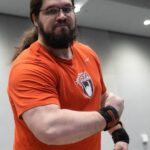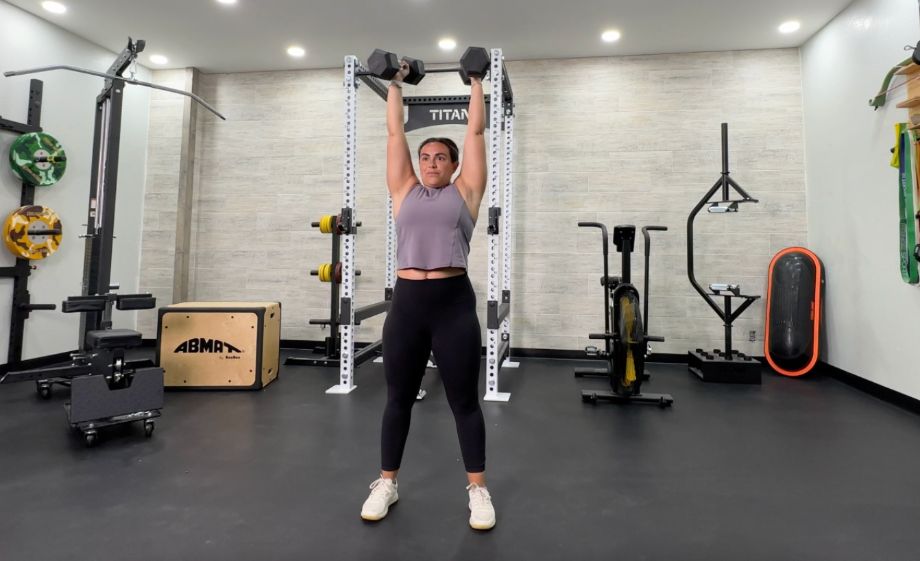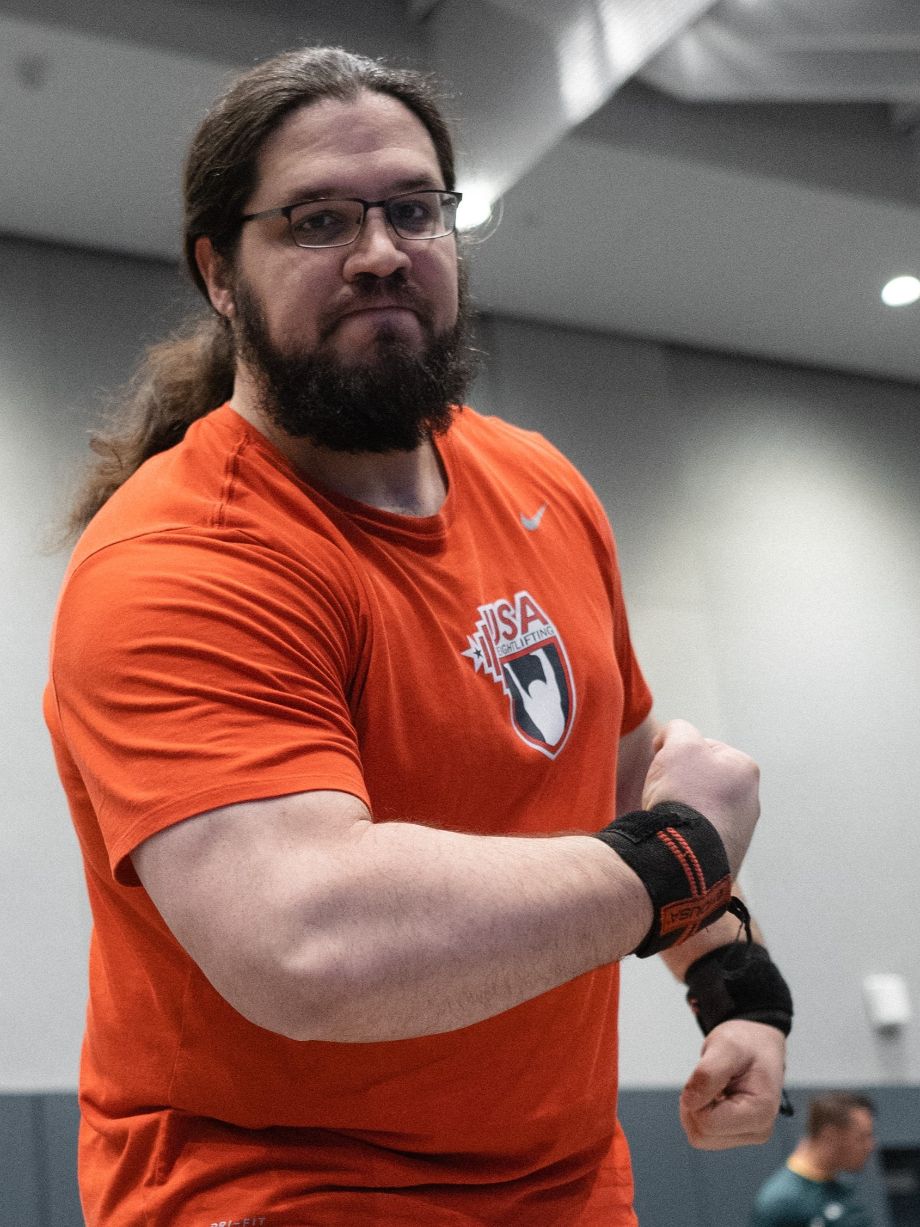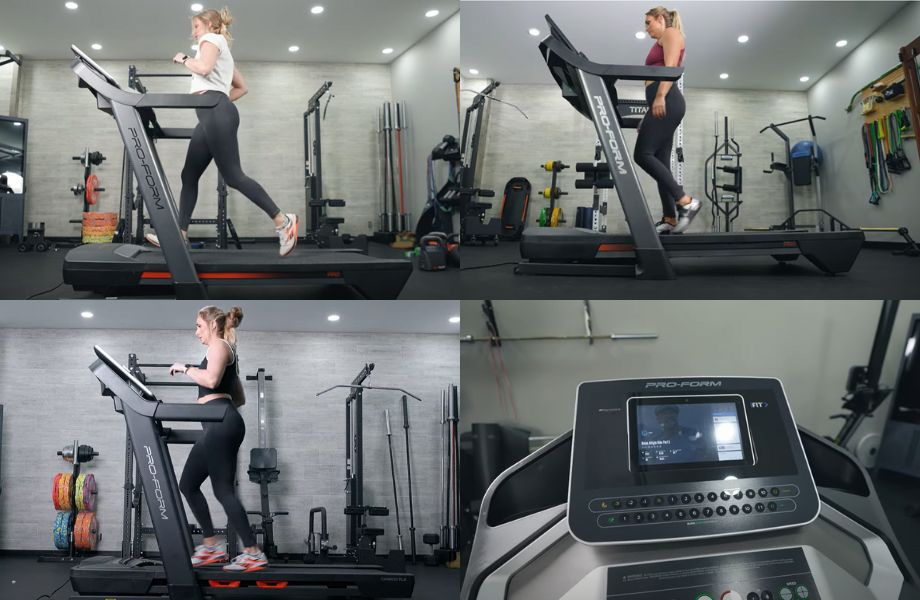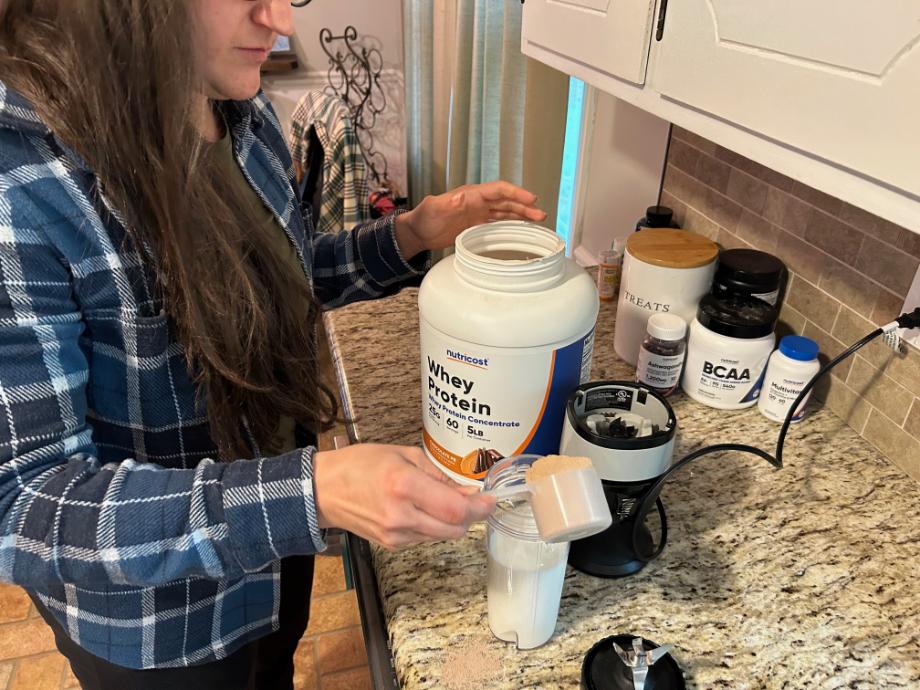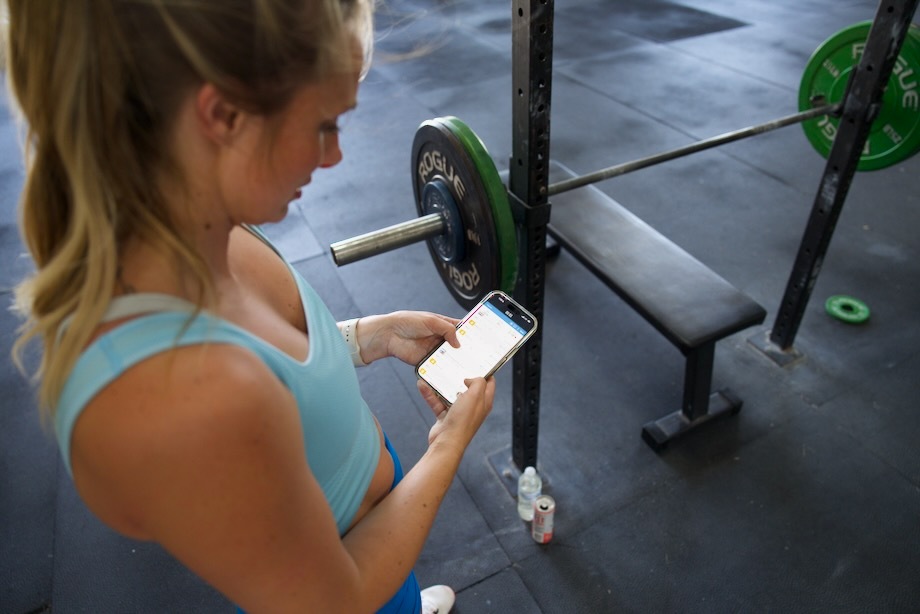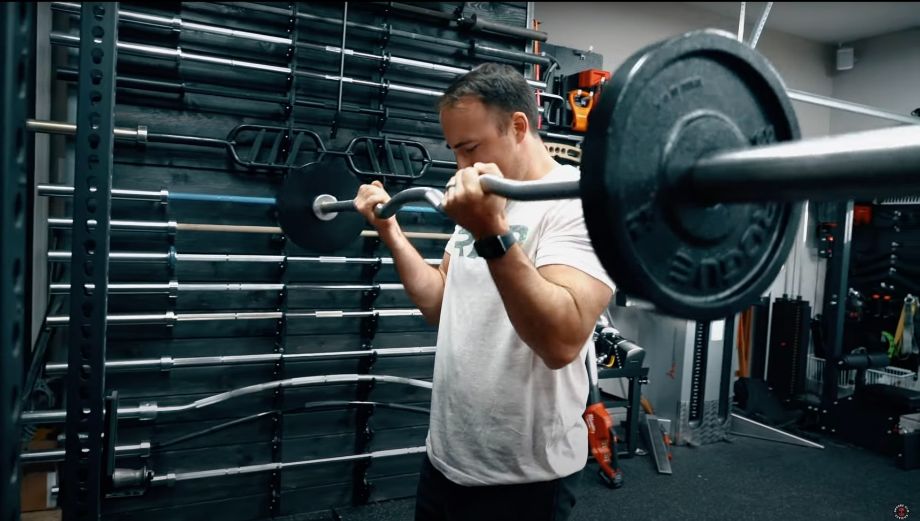Medical disclaimer: This article is intended for educational and informational purposes only. It is not a substitute for health or medical advice. For medical advice, contact an appropriate healthcare provider.
It can be difficult to get to the gym sometimes. Even if you have a home gym, finding the time to get in for a full workout can be tough. And if you’re not sticking to your typical workout routine, you might think you can’t workout at all; however, I’m here to tell you that’s not always the case.
Having coached over the years in CrossFit, weightlifting, and functional fitness, I’ve built a 30-minute full-body workout at home, easy for you to squeeze into a fast-paced day, and targeting the upper body, lower body, and everything in between. Plus, the best part is that you’ll only need some dumbbells to get the most out of this workout.
Full-Body Workout Overview
This full-body workout will be split up into three parts: a basic warm-up, a weight training portion, and then a cardio circuit to end your workout. It’s designed to be quick, and done within 30 to 45 minutes. Some of the movements are for more advanced fitness levels, so be mindful to adjust as needed.
If you’re ready to workout, make sure to have the following equipment:
- Dumbbells
- A chair or bench for one-arm rows
- Floor space
- An exercise mat (recommended, as you will be on the floor for a few of these movements, but not necessary)
Warm-Up
This warm-up is built to prime your entire body for the full-body workout. There’s no need to blaze through these exercises speedily. Rather, move at a moderate and consistent pace to emphasize proper technique.The main goal is to get the heart rate up and move your muscles through a similar range of motion as the exercises in the main workout.
- 2 rounds of:
- Cat and cow: 5 reps each
- Dead bug: 5 reps each side
- Inchworm: 5 reps
- Lateral lunge: 5 reps each side
- Bodyweight squat: 10 reps
Cat and Cow
- Start on your hands and knees, with the shoulders stacked over the wrists and the hips over your knees, maintaining a neutral spine.
- Move into the “cow” position by slowly arching the back, inhaling and pressing the chest forward and engaging the upper back—not just the lumbar spine.
- Reverse into the “cat” position by exhaling and rounding the spine and tucking in the tailbone, keeping the upper back involved by trying to spread your shoulder blades apart.
- Transition between the two positions slowly, maintaining a steady breathing.
Coach Tip: While transitioning between the two positions, your head will rise and lower with each movement, but don’t exaggerate it; let it happen naturally to let the neck remain neutral.
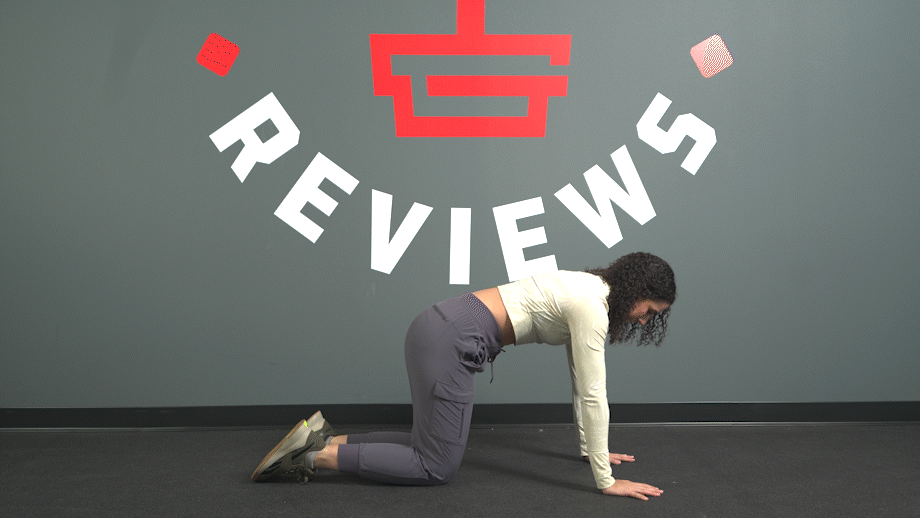
Dead Bug
- To find your starting position, lay onto your back and put your arms up towards the ceiling, then tuck your knees up until they are bent at a 90-degree angle, making your thighs perpendicular to the ground.
- Activate your core by pressing your lower back into the ground and tightening your abdominal muscles.
- Lower your right arm and straighten the left leg towards the ground, reaching as far as you can while still maintaining an engaged core.
- Bring the arm and leg back to the starting position, and repeat the movement on the opposite side, lowering the left arm and right leg this time.
- Alternate sides for multiple repetitions.
Coach Tip: Don’t rush through this movement. Keeping the movement slow and steady will help you maintain an engaged core, and it’ll also give you more of a workout, too, constantly keeping the obliques and other abdominal muscles engaged for a longer period of time.
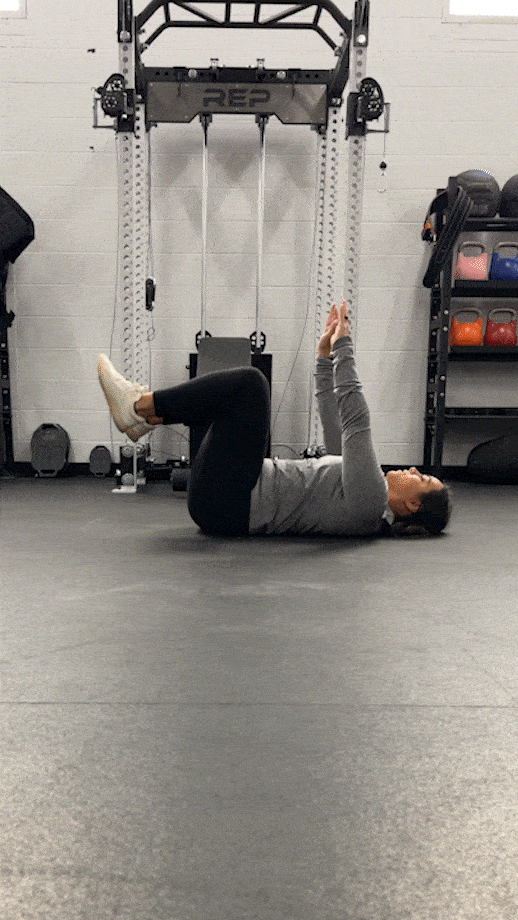
Inchworm
- Begin in a standing position with your feet shoulder-width apart.
- Bend forward at the hips, trying to keep the legs straight, and place the palms of your hands on the ground as close to your feet as comfortable (a good distance to aim for is about 6 inches from your toes).
- Walk forward with your hands, keeping the weight on the hands, until you are at the top of a push-up (or high plank position).
- Perform a push-up, chest to the floor and back up, keeping the core engaged.
- Walk the hands back, keeping the legs straight, until your palms are back to their starting position.
- Repeat for repetitions, and stand back up when complete.
Coach Tip: Especially in a warm-up, take time to feel that initial hamstring stretch when we place the hands down to the ground. Each time we reach that position in the inchworm again, linger a little bit to get a bit more of a stretch in.
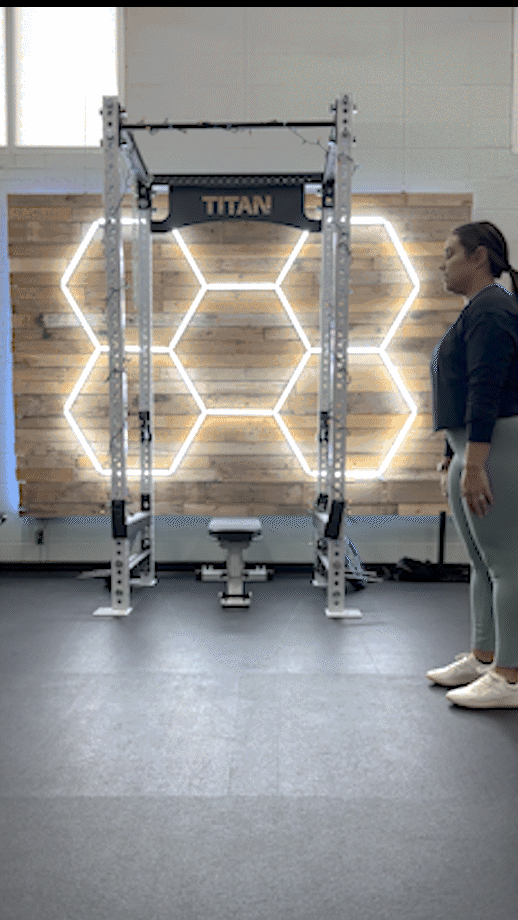
Lateral Lunges
- Start by standing tall with your feet together and toes pointing forward.
- Take a big step to the side with the right foot.
- Shift your hip back as you bend your right knee, keeping the left leg straight and toes still forward.
- Sink as low as you can comfortably, keeping your chest up and maintaining balance.
- Push with the right foot to straighten your leg and return to the starting position.
- Repeat for repetitions, alternating sides as needed.
Coach Tip: A common issue in a lateral lunge is letting the knee collapse or cave in as you lower yourself to one side. Focus on shifting back on the hips to try to keep all major parts of the leg in line. Also, keep the chest up to maintain solid form throughout the movement.
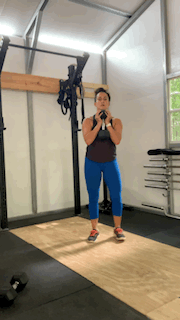
Bodyweight Squat
- Begin with your feet about shoulder width apart with the toes pointed outward slightly, and your core engaged and braced.
- Let the hips shift back slightly to begin to lower yourself into a squat, the knees bending and tracking over your toes. Also, keep the chest upright and core engaged.
- Aim for a low depth, ideally below parallel, but if that depth is unsafe or technically unsound, then go as low as possible while maintaining proper squat form.
- Press into the heels and squeeze with the glutes to drive the legs back up to your starting position.
- Repeat for repetitions.
Coach Tip: Squats will look different person to person, so focus mostly on hitting the major technical points—flat feet, a tight core, and upright chest—instead of matching your squat form perfectly with your favorite fitness influencer (mine’s Martins Licis).
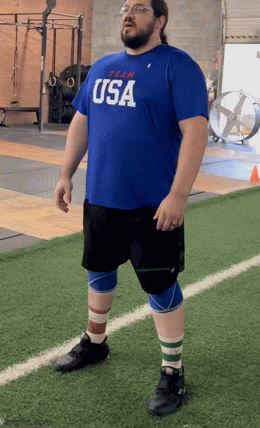
Weight Training
The first section of this full-body workout will focus on strength training, performing all three sets of each exercise in order, taking small, short breaks in between each set. This workout will have a pretty good balance between building strength and getting the heart rate up. Because the reps are higher, we’ll want to choose a weight that we can perform each set unbroken.
- Dumbbell thruster: 3 sets of 8 reps
- Dumbbell one-arm rows: 3 sets of 12 reps each arm
- Romanian deadlifts: 3 sets of 10 reps
Dumbbell Thruster
- Begin in the standing starting position of a squat, but with a dumbbell in each hand at shoulder height, focusing on keeping the elbows up. One head of the dumbbell can be resting on the shoulder.
- Lower yourself into a squat, maintaining an upright torso and keeping the elbows high in your front rack position.
- Drive through the heels aggressively to begin returning to standing.
- As you reach the top of the squat, drive the legs up and then push the dumbbells overhead, until the arms are locked out overhead.
- Bring the weights back down to the shoulders to begin your next rep.
Coach Tip: If you’re new to dumbbell thrusters, the main goal is to get the power of the legs to begin the press upward. The more power and drive with the legs you can provide, the easier the press overhead will be.
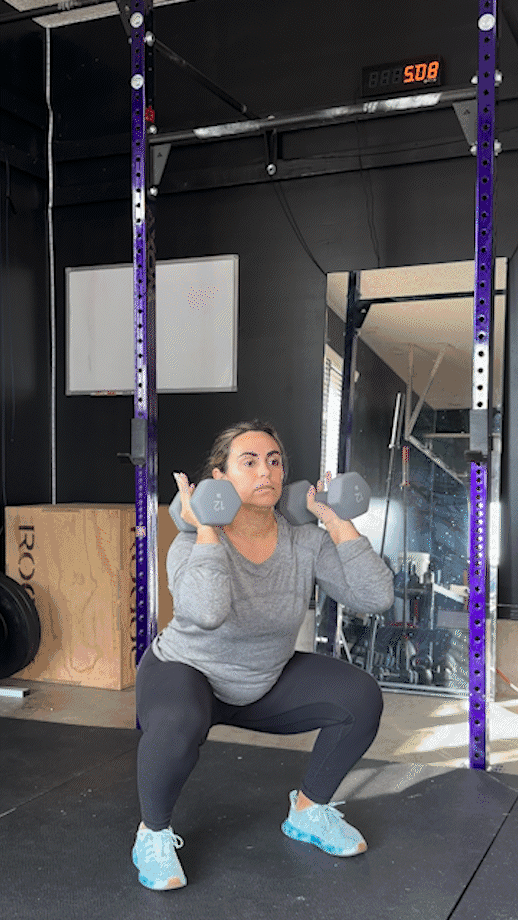
Dumbbell One-Arm Row
- With a dumbbell in your right hand, bend over a chair and place your left hand onto it to stabilize yourself. If you have a bench or couch (or a chair large enough), you can place your left knee on it for further support.
- Set your back tight and engage the core.
- Begin to row with your right arm, squeezing your shoulder blades together, and leading with the right elbow, not the shoulder.
- Bring the dumbbell up to your torso, and then control the dumbbell back down, maintaining tension in the upper back.
- Finish all repetitions on one side before switching to the other side.
Coach Tip: Rows can be a great way to build muscle if you’re doing them properly. A common mistake is using the shoulders to pull weight up. Think more about rowing the weight up like you’re starting a lawnmower to help you get the lats and upper back involved.
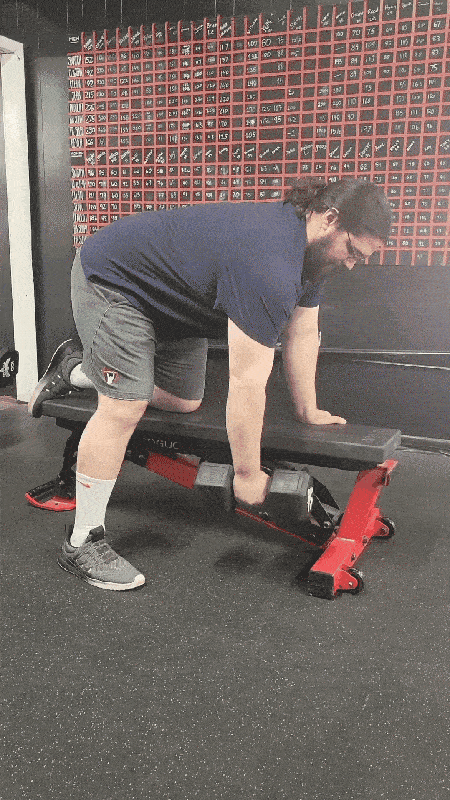
Dumbbell Romanian Deadlift
- Stand with your feet hip-width apart, holding a dumbbell in each hand.
- Keeping the upper back engaged, let the hips shift back slightly as you lower your chest and dumbbells downward.
- Continue downward until you feel a stretch in the hamstrings, ideally not letting the dumbbells touch the ground (keeping the posterior chain active throughout the entire movement).
- Drive the heels and fire the glutes to bring your upper body and the weights back to a standing position.
- Repeat for repetitions.
Coach Tip: For a challenging variation, try a single-leg RDL, where you let your left foot and leg lift back as you lower the dumbbells (then switch legs). This is a great way to do some unilateral training as well.
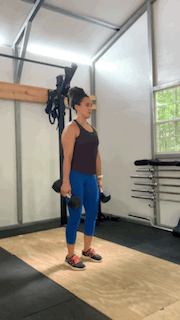
Cardio Circuit
After doing some strength work, we’ll end with a cardio-focused circuit. The exercises are still focused on a full-body workout, but they’ll be done within a circuit, taking short breaks after each round of exercises.
- 3 rounds of:
- Burpees: 10 reps
- V-ups: 20 reps
- Dumbbell farmer’s carry: 45 seconds
Burpees
- Start by standing tall with your hands by your sides and feet at hip-width apart.
- Bend forward and place the palms of your hands on the floor.
- Then kick or step your feet back into a plank position, keeping the core tight and back straight.
- Lower your chest and hips to the floor, letting your elbows bend in the process. Then push back up to the plank position.
- Hop the feet up towards your hands, bring your arms off the floor, and drive up into a jump, extending your arms overhead.
Coach Tip: I’ve coached a lot of CrossFit classes to know that this bodyweight workout can become sloppy very quickly. Do your best to maintain proper form on a burpee, however, as it will help train your core and body strength, instead of just being a cardio burn.
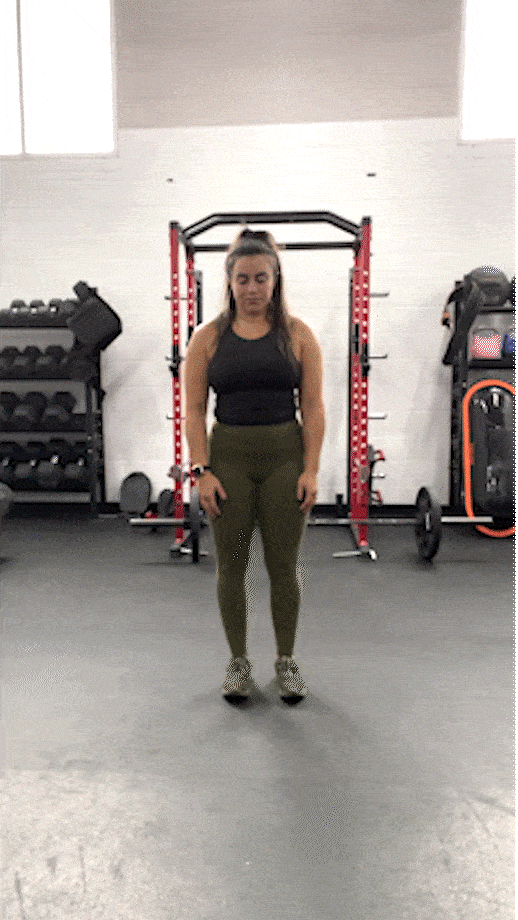
V-ups
- Lie on your back, with legs straight out on the floor, and your arms straight out over your head, palms facing up.
- Lift your legs and arms up at the same time, trying to touch your toes while keeping the arms and legs as straight as possible.
- Slowly lower yourself back to the starting position.
- Repeat for repetitions.
Coach Tip: V-ups are great for your core, but for an exercise more for the obliques, you can try a variation called alternating jackknives. Maintaining a hollow hold, lift one leg and the opposite arm together, then alternate. Try it out!
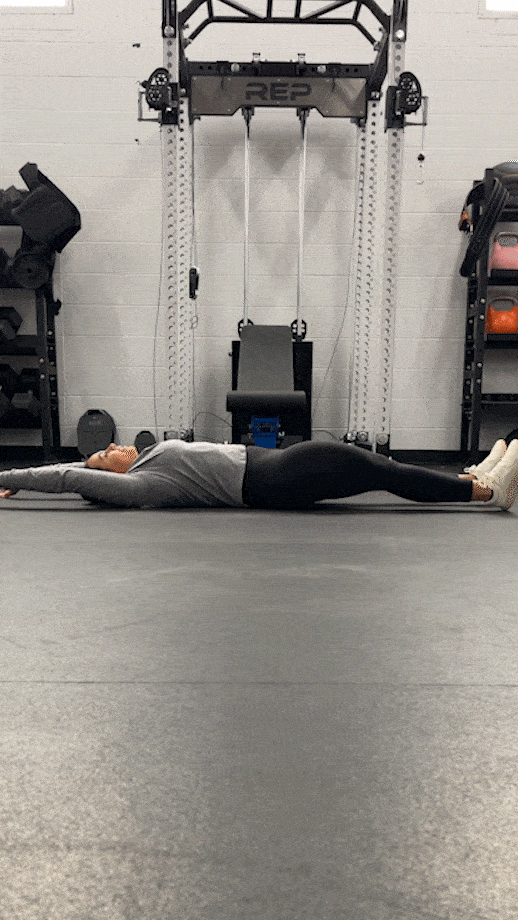
Dumbbell Farmer’s Carry
- Start with a heavy dumbbell in each hand, standing upright and arms at your sides.
- With an active, engaged core and strong shoulders (think back and down), walk forward in a straight line.
- Walk for 45 seconds, or a specified distance like 100 feet, turning around and reusing the same floor space as needed.
Coach Tip: If you’ve picked the right weight, you’re going to want to rush these farmer’s carries, so you can set them down. Instead, focus on maintaining proper form in the back and core, to get the most out of this exercise.
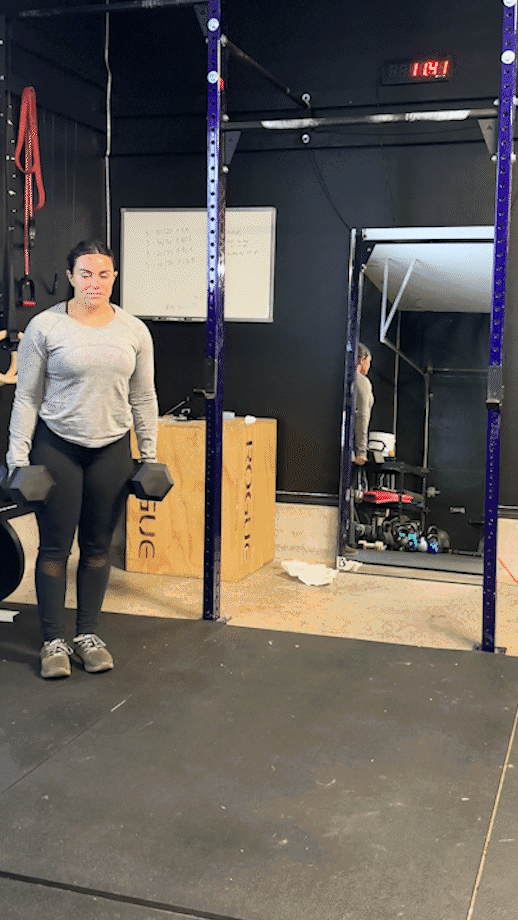
Tips for Full-Body Workouts
Here are a couple things to think about for this and other full-body workouts.
Technique First
The main thing to emphasize in any exercise is form, first and foremost. If a lot of these movements are new to you, slow it down and focus on good movement. As you get more comfortable with these exercises, you can add some more weight or move through the movement a little quicker, but make sure to build a solid foundation first.
Adjust the Reps Based On Your Weights
What if your dumbbells are too light or too heavy for the repetitions and sets I suggested? The simplest way to modify the workout is to adjust the rep count. If your dumbbells are too light for dumbbell RDLs at 10 repetitions at a time, then increase the rep count to 15 or even 20 repetitions to get a good stimulus for your RDL workout. Likewise, if your weight is too heavy for thrusters, try fewer repetitions.
Add Variety
Need more workouts for your week? You can repeat this workout a couple times a week for a bit, but it might start to feel stale. One option is to change around this full-body workout a little bit. Mix in some other great full-body exercises for variety. A few good options include:
- Push-ups
- Dumbbell lunges
- Pull-ups
- Mountain climbers
- Renegade row
Replace an exercise with one of these, for three sets of 8 to 10 repetitions to help get a little more variety in this workout.
You can also check out this collection of 30-minute workouts (although some more equipment may be needed).
Full-Body Workout at Home FAQs
What are the best exercises for the whole body?
Although many exercises are considered upper or lower body workouts, quite a few exercises train multiple muscle groups across the entire body. These exercises are great at developing functional fitness. While the best exercises for the whole body can vary person to person (it’s the exercise you’re willing to do!), a few common full-body exercises are:
Pull-ups
Squats
Deadlift
Clean & jerk
Burpees
Turkish get-ups
This is by no means a comprehensive list of full-body exercises, but several great examples.
Is it okay to do a full-body workout every day?
It’s possible to do a full-body workout each time you train; however, most people will benefit from a rest day or two each week to let muscles recover. It’s also wise to still vary your workouts, emphasizing different muscle groups each day to avoid overtraining.
What’s better: full-body or split workouts?
There are certain advantages and disadvantages between full-body workouts and split workouts. While a quicker workout that can burn more calories, full-body workouts can run the risk of overtraining, since you’ll be working out the same muscle groups multiple times per week. Split training might help build more muscle mass, but fewer calories are burned.
Which program structure is best suited for you will depend on your goals and fitness progression, along with the amount of time you have to dedicate in the gym.
RELATED: Full Body Workout Vs Split Workout
How long should a full-body workout be?
There’s no exact time a full-body workout should be. Even if time is limited, 20 minutes can still be plenty of time to get an effective workout. Typically, workouts lasting about an hour, or just under, will allow you the time to fatigue the whole body through multiple sets and exercises, and also allow reasonable rest between sets.
How long your particular workout should last will heavily depend on the time you have available, as well as your fitness goals.

